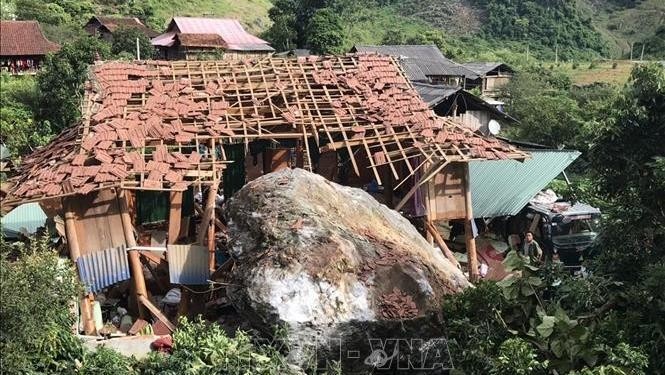According to a report by the Ministry of Agriculture and Rural Development, there were 92 thunderstorms, tornadoes, hailstorms, and heavy rains in the northern mountainous provinces in the first months of 2020, higher than the total number in the entire year of 2019.
Of these, there were eight downpours on a large scale and two flash floods and landslides that caused serious damages to houses, with about 54,000 houses having collapsed, been damaged or ending up unroofed.
Over the past week, heavy rains in the provinces of Lao Cai, Dien Bien and Ha Giang, killing nine people and destroying many houses, crops and roads.
In Son La city, the sailing stone phenomenon occurred in Bom Nam hamlet in Chieng Den commune and Pung hamlet in Chieng Ngan commune on August 8, killing one person and injuring another.
Dangerous natural disasters are major challenges facing the northern mountainous region. Landslides and flash floods frequently occur in the region and have caused high mortality rates in recent years.
The northern mountainous region also has many large hydropower and irrigation reservoirs, posing a high potential risk if the prevention and response to floods is not conducted in a reasonable and harmonious way.
The northern mountainous area has been identified as a focus area of flash floods and landslides, thus more proactive action and drastic measures are required to minimise potential damage caused by natural disasters.
The Ministry of Agriculture and Rural Development issued Document No. 4793/BNN-PCTT on July 18 on the implementation of natural disaster prevention and control measures in the northern mountainous region in 2020.
Accordingly, all localities in the region are requested to review and check the safety of residential areas along rivers and streams, low-lying areas with a risk of flooding during heavy rains, mines and mineral exploitation sites during the rainy season.
It is also necessary to resolutely prevent illegal mineral exploitation to avoid landslides and tunnel collapses as well as avoiding the collection of firewood in rivers and streams during floods to avoid unfortunate incidents.
In particular, it is advisable to prepare response plans, human resources and equipment to timely carry out rescue work if needed, especially when flash floods and landslides occur on a large scale and isolate residential areas.
Northern mountainous provinces should assign local forces to check unsafe public buildings, residential areas, lakes, and dams in addition to blocked streams and take measures to evacuate people, place warning signs, and remove obstacles to avoid water accumulation and floods.
At the same time, irrigation reservoirs must be regularly supervised to promptly handle arising issues while water storage is not allowed for lakes under construction or where it is not guaranteed to be safe.
In the long term, localities should give priority to allocating local budgets and other legitimate sources to activities on natural disaster prevention and control, especially flash floods and landslides. In addition, community capacity and command capacity to respond to natural disasters and carry out rescue work should be improved.
Amid the impacts of climate change and extreme weather events, long-term solutions should be devised to proactively respond to and deal with natural disasters. An overall roadmap must be developed to rearrange the entire population of the 13 provinces in the northern mountainous region to ensure the highest levels of safety amid regular floods.
















